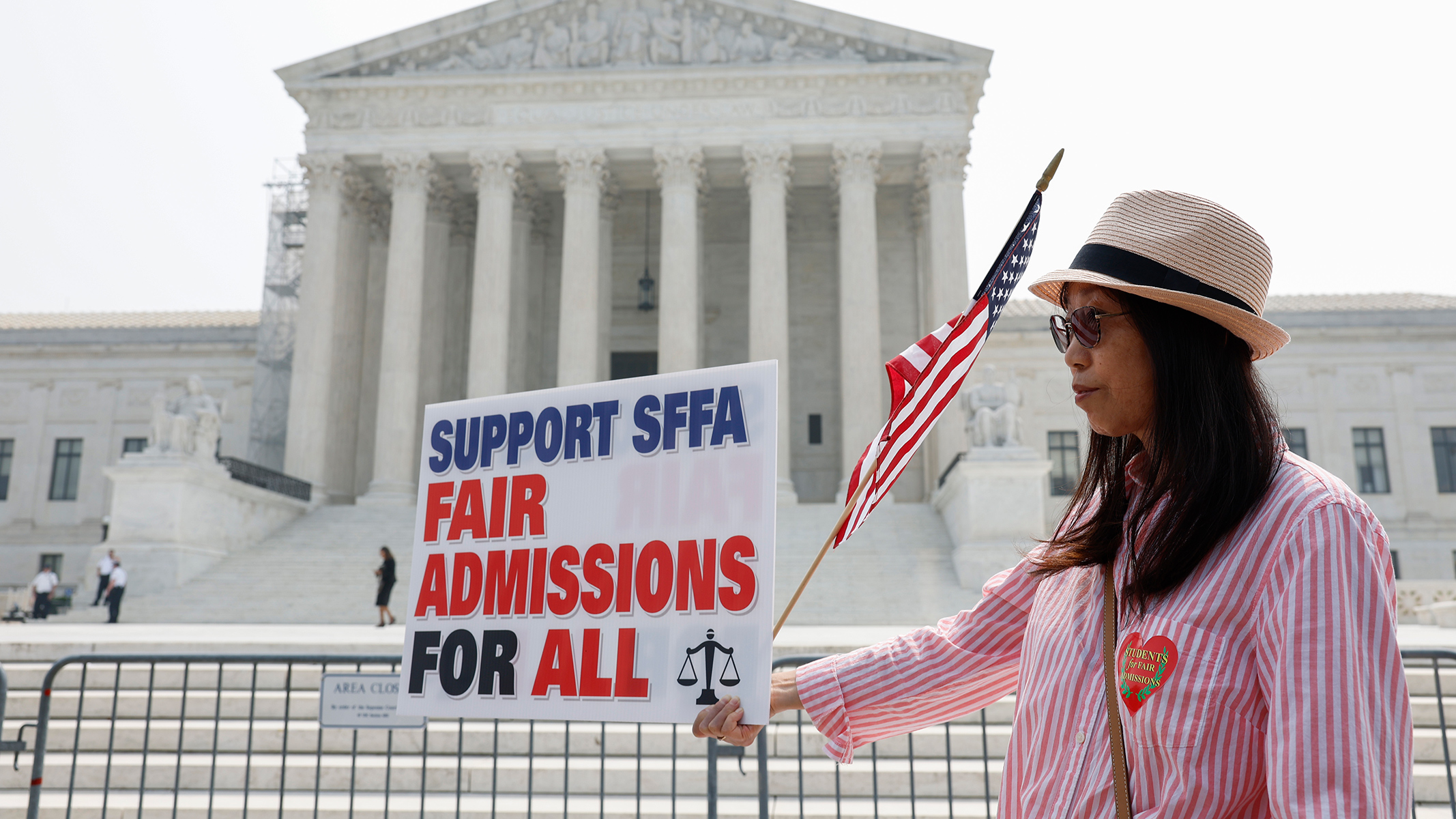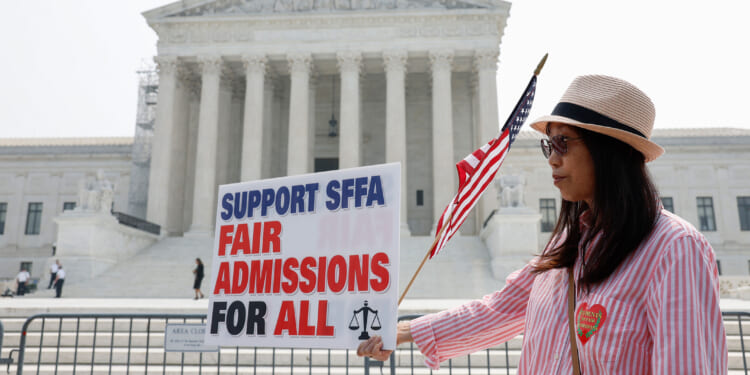
The Fall of Affirmative Action: Race, the Supreme Court, and the Future of Higher Education, by Justin Driver (Columbia Global Reports, 280 pp., $18)
For decades, American universities practiced systematic racial discrimination in admissions. They actively and explicitly privileged Hispanic and especially black applicants over white and especially Asian applicants.
Finally, a reason to check your email.
Sign up for our free newsletter today.
This discrimination was particularly pronounced at the nation’s elite universities. At Harvard, for example, Asian students in the top decile of academic performance had the same chance of admission as black students in the fourth-lowest decile. Had Harvard admitted students by a random lottery, choosing among applicants in the top decile of academic performance, Asians would have made up over 50 percent of the class. Between 2014 and 2019, however, Asians made up just 25 percent of the university’s admitted students, something Harvard allegedly achieved by penalizing Asian Americans for having supposedly worse personalities.
Last year, the Supreme Court ruled in SFFA v. Harvard that universities cannot discriminate on the basis of race in admissions. The decision was met with outrage on the self-identified anti-racist left. In his new book, The Fall of Affirmative Action, Yale Law School professor Justin Driver laments the end of racially discriminatory university admissions policies—better known, of course, as affirmative action.
“SFFA has struck at the very heart of elite American higher education,” he claims, and “the decision constitutes a veritable catastrophe not just in higher education but in our larger national life.” Driver intends The Fall of Affirmative Action as a kind of post mortem, noting his desire to give affirmative action “a proper burial” and concluding with “an elegy” for the policy. What his book makes most clear, though, is how weak the case is for racial preferences.
In the book’s theoretically substantive first half, Driver explores legal arguments advanced by conservatives and liberals regarding affirmative action. While one might have expected him to lead with a knockout argument in favor of the policy, Driver devotes the book’s first chapter to what he calls the conservative case against SFFA. In effect, he recycles conservative scholars’ objections to affirmative action as considerations against the new admissions regime created by SFFA.
This might seem puzzling: how can objections to affirmative action be made into objections to SFFA? But Driver quotes Chief Justice John Roberts’s remark for the SFFA majority that its opinion does not prohibit “universities from considering an applicant’s discussion of how race affected his or her life.” This concession, Driver claims, means that SFFA will fail to have the effect that the conservative majority intends. Instead, it will result in a “newfangled essay-based regime,” under which “Black and brown applicants are strongly encouraged to produce narratives of racial woe.” Driver argues that SFFA encourages universities to find more subtle, and therefore potentially more insidious, ways to discriminate racially in admissions.
That universities will do their best to flout the spirit of SFFA is plausible enough. But that SFFA on its own may not fully counteract the entrenched bias of university admissions committees against white and Asian applicants hardly demonstrates that the decision is not a necessary step in the right direction. In the majority decision, Roberts also warns that “universities may not simply establish through application essays or other means the regime we hold unlawful today.” If universities ignore Roberts’ warning, the Court may take a harder line in the future.
Next, Driver turns to liberal legal scholars’ arguments in favor of affirmative action. He contrasts the dominant conservative understanding of the Equal Protection Clause (that it prohibits treating races differently) with the influential liberal understanding (that it prohibits treating any race as inferior).
Racially discriminatory admissions policies are clearly unjustified given conservatives’ “anti-classification” interpretation of anti-discrimination law. But as Driver explains, it is far from clear that the liberals’ “anti-subordination” interpretation justifies affirmative action. After all, doesn’t systematically downrating the personalities of Asian applicants constitute treating Asians as inferior?
After canvassing the legal arguments for and against affirmative action, Driver turns to prescription and diagnosis. Here, he squanders the impression of intellectual good faith earned by his honest recognition of weaknesses in the liberal case by exploring ways that universities could reestablish the regime struck down in SFFA. He even touts the potential benefits of adopting a university policy that “immediately draws litigation that eventually results in an adverse Supreme Court ruling,” since it would take considerable time for such litigation to wind through the system. Though he later adds that he “unreservedly denounce[s] . . . defiance of SFFA,” readers may not be convinced.
Readers also should not be impressed when Driver presents SFFA as an illustration of “the abhorrent politics animating the conservative movement’s attack on racial diversity.” His barely disguised charge against proponents of SFFA here—a running theme in most liberal-progressive responses to critics of affirmative action—is racism. To get this serious charge to stick, Driver tries to manipulate readers’ emotions. For instance, he describes one woman in Baltimore as having been “so shaken, so despondent” by the Court’s ruling “that she felt compelled to sit down to contemplate ‘the type of history being made at that moment.’” He also presents the supposedly “evocative” and “dispiriting” example of a college student who was discouraged by SFFA from applying to “his dream college”—Harvard.
Such overwrought examples are best dismissed as a bluff. They prove nothing. That young people of some races have come to expect preferential treatment, while young people of others have grown inured to seeing their college applications discounted, does not make systematic racial discrimination in university admissions any less wrong or unfair. More generally, the idea that it is racist to oppose unequal treatment on the basis of race inverts reality. In SFFA, the Court’s majority recognized this. It’s past time that professors at elite law schools, unable to argue against SFFA on the merits, have the integrity to do the same.
Photo by Anna Moneymaker/Getty Images
City Journal is a publication of the Manhattan Institute for Policy Research (MI), a leading free-market think tank. Are you interested in supporting the magazine? As a 501(c)(3) nonprofit, donations in support of MI and City Journal are fully tax-deductible as provided by law (EIN #13-2912529).
Source link


















